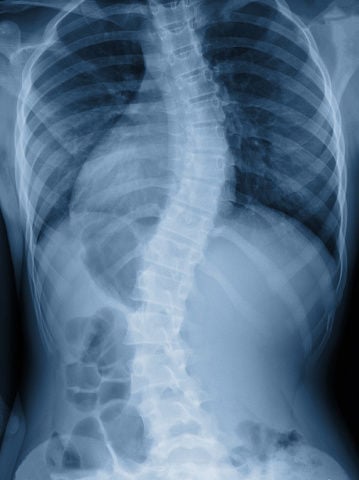When you look at the profile of a normal back, you see gentle curves. Spines are shaped this way for flexibility and balance. But if a spine curves from side to side, the person could have a common condition called scoliosis.


Who gets it?
About 3 percent of people in the U. S. have some degree of this abnormal curvature of the spine.
Anyone can have it, and your risk is higher if a close family member has it.
Signs and symptoms usually begin between the ages of 9 and 15, during the child’s growth spurt. Girls are more likely than boys to develop scoliosis.
Some babies are born with congenital scoliosis, which happens when one or more vertebrae don’t form properly. Adults with scoliosis have usually had it since childhood, though it sometimes develops later in life.
What causes it?
Most cases of scoliosis are idiopathic, which means that the cause is unknown. However, it’s sometimes caused by an injury or by conditions such as cerebral palsy, muscular dystrophy or spina bifida. Adults with arthritis of the spine or degeneration of spinal discs sometimes develop scoliosis.
What are the symptoms?
Scoliosis is usually mild and often causes no pain or discomfort. Some children with scoliosis may have a backache or their backs may feel tired after sitting or standing for a long time.
Since scoliosis develops gradually, the abnormal curvature of the spine may not be obvious. Instead, parents, teachers or coaches may notice these signs in a child:
- Shoulders or hips that are uneven.
- One shoulder blade that is higher or protrudes more than the other.
- Rib cages that are at different heights.
- The entire body leans to one side.
- The head is not centered over the pelvis.
How is scoliosis diagnosed?
If you think your child may have scoliosis, schedule a visit with your doctor. He or she may start with a simple screening exam called forward-bend test. With this test, the child bends forward 90 degrees with feet together and arms dangling. Viewed from behind, this position can reveal irregularities in the spine.
Your doctor may also ask about symptoms, do a physical exam, and ask if anyone in the family has been diagnosed with scoliosis. If he or she suspects a problem, the next step may be an X-ray to confirm the diagnosis and find out how severe it is.
How is it treated?
There is no cure for scoliosis. However, for most children with this condition the abnormal curve in their spine is mild and doesn’t need treatment. Doctors may recommend regular checkups to see if there have been any changes in the child’s condition.
In some cases, such as a more severe curve or one that is S-shaped instead of C-shaped, treatment may be necessary. Doctors also consider the location of the curve and the age of the child when deciding how to treat scoliosis. Babies born with congenital scoliosis are more likely to need treatment.
For younger children, whose bones are still growing, wearing a brace can help prevent the curve from getting worse. Kids who wear these braces have few activity restrictions, and can take off the brace to participate in sports. They stop wearing the brace when they reach the age when bones are no longer growing.
For severe scoliosis, surgery may be necessary to keep it from progressing. Surgery may involve fusing several vertebrae together so the spine doesn’t continue to curve, and attaching metal rods to hold the bones in position while they heal.
What is the outlook for people with scoliosis?
People with mild scoliosis don’t usually have long term problems, though some back pain is possible as they get older. The more pronounced the curve, the more likely it is for other symptoms to occur, such as persistent pain or nerve damage. Some people with severe scoliosis have trouble breathing. Treatments can help relieve these problems.
Children and teenagers who are diagnosed with scoliosis may feel angry or fearful, and self-conscious if they wear a brace. They do better with strong support from family and friends. A support group for parents and kids with scoliosis is a good place to start.
Treatments for scoliosis have improved over the years – braces are lighter and more comfortable, and surgeries are more effective. Most people with this condition can be as active as they want. In fact, exercise – including sports – is important for keeping bones strong and staying fit.
To learn more about scoliosis, visit the American Academy of Orthopedic Surgeons at orthoinfo.aaos.org.
Source: Missoulian,11th April 2016

No comments:
Post a Comment